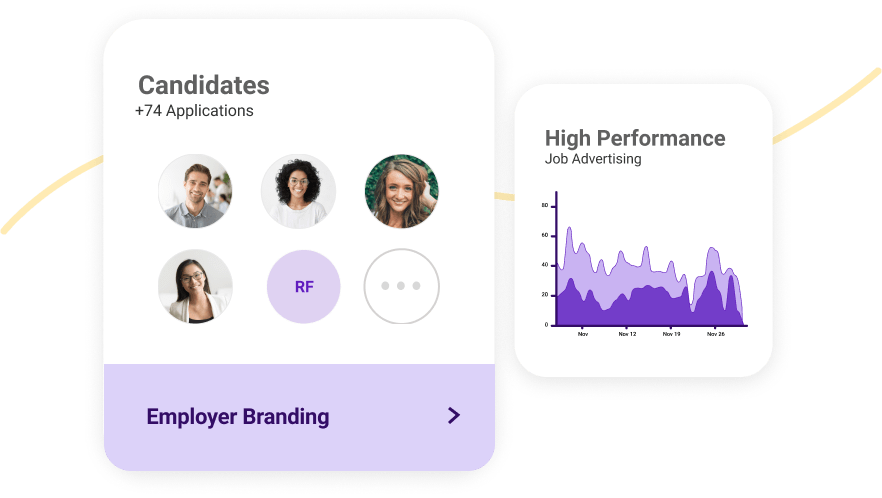Sourcing Candidates for High-Volume Hiring
Top talent isn’t always scouring the internet looking for jobs. Many of them are waiting to be found. On the other hand, many people are looking for employment, and employers are struggling to find them.
Whether it is because of a weak talent pool, a small budget, or a lack of social media awareness, many companies’ sourcing strategies are suffering.
When you’re looking for a high volume of qualified candidates, you need to get a little creative about where you search. Here are some top sources of great candidates:
- Recruiting databases
- Job boards
- Social media recruitment marketing
- Digital and programmatic advertising
- Hiring events (in-person and virtual)
But are you using them effectively?
Let’s walk through the top sources that recruiters use to reach a high volume of candidates to get you meeting your hiring goals.
Sourcing via a Recruiting Database

Candidate sourcing is a complicated and sometimes draining process. You have lots of groundwork to do – like understanding the job position and the candidate persona that fits it – before you can start your search.
Once you do, however, most recruiters agree that there is one clear place to begin looking: your recruiting database!
This talent pipeline, which you have built out across many years and roles, is a great resource to aid your recruiting efforts. Just because someone didn’t make the cut the first time around doesn’t mean they don’t deserve a job with you at all. Re-evaluate candidates and reach out to the ones that catch your eye. Often, the things that interested them about your company the first time around are enough to make them consider reapplying.
Use your applicant tracking system (ATS), candidate relationship management (CRM) software, or other database with stored applicant information to begin your evaluation.
Another thing to keep in mind with this sourcing pipeline (a.k.a., recruiting database, a.k.a., talent pool) is passive candidates. Many people aren’t quite looking for a job yet, but they could consider switching jobs if offered.
It’s essential to keep top talent in your system and continue delighting them with relevant content. Follow candidate nurturing best practices to keep people engaged and willing to stay in your audience.
Sourcing Online

Modern-day recruiting means getting comfortable online.
Yes, job postings used to call newspapers home, but now nearly everything is digital. And it’s not just websites that are getting traffic. Social media is changing the way recruiting works and is now a major avenue for finding talent.
Master the art of sourcing online by nailing job boards, social media, and multiple forms of digital advertising.
Job boards
Most employers choose to publish their jobs on at least one major job board to attract candidates.
However, paying for postings can get expensive, and there is a bigger issue that most recruiters know about. Boards are a great way to get lots of eyes on your job postings, and often, lots of applicants. But many of them – sometimes, most of them – are not qualified.
Job boards should be part of your strategy, but they can’t be the only trick a recruiter has up their sleeve.
To improve your job board posting strategy, make sure that you’re making effective use of job posting optimization. Keep the job title short but, consider adding a major benefit of working for your company within it. For the post itself, be sure to focus on the things you think your target candidate audience wants to hear. Include benefits, salary, and any other information that makes you stand out.
Additionally, what job boards are you posting on? What job boards should you be posting on? There are some big names out there, and they’re the route that most recruiters tend to take. Don’t forget about the little guys on your journey, though. Niche job boards (industry-specific, location-specific, etc.) can be invaluable in finding candidates you might be missing.
Social media
Social media has affected most aspects of modern-day living, and recruiting is not excluded from that conversation. These platforms (even the ones that don’t seem professional in nature) can be great recruiting tools.
Think about it – you’re meeting candidates where they are. Whether or not you’re there, they will be, making social media a huge recruiting opportunity.
Don’t know which platforms will generate leads for your recruitment pipeline? Try out these big players:
- LinkedIn. The most popular form of professional social media, LinkedIn was created to be both a jobs site and a social networking platform. LinkedIn is a great place for B2B brands to thrive, but also for companies to find candidates. People build profiles of their professional achievements, allowing companies to see if they fit their job requirements. Though LinkedIn isn’t great for every industry as it leans very white-collar, it is a growing platform that can absolutely provide quality leads.
- Glassdoor. This is a popular employer branding platform. It allows companies to post jobs, updates, and information about what it’s like to work for them. Another primary function of the platform is for current and previous employees to leave anonymous reviews. This puts the power in job seekers’ hands because they get to see honest, consequence-free reviews about what their future role might look like. Glassdoor provides a great opportunity for employers to find candidates, but also to pull them in by establishing a strong employer brand and proving that you’re a good place to work for.
- Instagram and Facebook. Though neither are professional in nature, both can be used as recruitment marketing tools. As visual platforms, you can use pictures and videos that show off your culture to your advantage. You can also use paid ads with their advanced targeting tools to find users who are potential candidates.
You can also use LinkedIn and Facebook groups as spaces for people with relevant interests to gather and share resources. Social sourcing is an increasingly important piece of high-volume recruiting. Incorporate these platforms into your strategy by using them as employer branding tools, posting about career opportunities, and, of course, finding potential candidates.
Digital advertising
Recruitment advertising can mean a lot of things. Paying to post on a job board is recruitment advertising. So is promoting a post on social media. Any posting or piece of content that you pay to see grow in views, impressions, or clicks is digital advertising.
Beyond job boards and social media (which should both be a major piece of your paid ad strategy), you should also consider paying to promote your job postings via search engine marketing. Google ads have some of the widest range of any advertiser. They also base where and how they place their ads on what people search for. Thus, the views and clicks they deliver are usually relevant ones.
Programmatic advertising takes this a step further. It allows you to build relationships and target specific candidate groups. You can do things like ask a group to apply for a job or invite them to a hiring event with the click of a button. Programmatic allows you to find people at the right place and the right time. It has the potential to lower your CPA and more easily hire at scale.
Keep in mind that finding good candidates and getting them to apply are two different things. Make sure to test ad copy across platforms and ad types to see what best attracts your audience.
Sourcing via Your Own Organization

Internal recruitment should never be discounted as a sourcing method.
In fact, many recruiters recommend that your organization should be the first place you turn to when it comes to filling open positions. This may be less helpful for high-volume recruiting, where you aren’t just looking for a few new faces to fill your office, but lots of people in specific positions. However, it is still a valid, and often fruitful option.
Leverage your employee contacts and even past employees to tap new sources of talent that can be verified by people you trust.
Employee referrals
Employee referrals are a smart and cost-effective sourcing method.
People are more likely to trust a friend or connection over a cold email from a company when it comes to job hunting. Additionally, passive candidates are much more likely to take an opportunity seriously if it’s coming from someone they have a working relationship with.
Employee referrals can:
- Reduce your time to hire
- Improve your quality of hire
- Increase your retention rate
Because employee referrals can be so effective, many companies offer incentives. Build an employee referral program to ensure that good referrers feel appreciated and continue to recommend top talent.
Examples of referral rewards include assigning a monetary value to certain positions (a higher dollar amount for harder-to-fill positions), offering additional paid time off, or even incorporating an office-wide competition for most referrals.
Past candidates and employees
Ideally, your talent pipeline should include interested candidates and stakeholders as well as previous applicants and, if they choose to stick around, even past employees.
Don’t lose any of the past work you’ve done to recruit. Like we mentioned earlier, you should use the talent pipeline that you spent so much time building to your advantage.
Past candidates didn’t end up getting the job, but what about a year from now, when they’ve gotten more experience? Maybe your talent pool was stronger last time around and this person could still be a good hire. Give your talent pool another look and make sure you’re not missing any quality workers a second time around.
For past employees, your verbiage will have to be more delicate, and your offer will probably have to be better than the first time around. These people may have had a negative experience with your company that caused them to leave. It’s still worth it to try and leverage these relationships and hope that your brand experience was positive enough to get people to reconsider. Consider opening a conversation with a past employee less formally, and by a face that’s familiar to them.
Sourcing via Hiring Events

Hiring events should always be a sourcing option in the back pocket of high-volume recruiters.
If you want to fill your candidate funnel quickly, hiring events are an excellent option. They allow you to meet many new faces at once, promote your employer brand, and engage candidates at different points in the recruiting journey.
There are many types of hiring events to choose from, but the main choice boils down to online or in-person.
Whatever type of hiring event you choose, you’ll get the chance to be face-to-face in some form with candidates. They have the potential to increase the size of your talent pool, lessen your time to hire, and improve your entire candidate experience.
In-person hiring events
In-person hiring events are a tried-and-true method for getting talent in the door.
Job fairs are a good method for increasing your quality of hire. Those showing up to a job fair are either interested in your company or ready for a new opportunity in the near future.
One option for a job fair event is an on-site open house. These events are great for people who will be joining your office space and can take this time to envision themselves there. They are also a lower-cost option since there is no charge for a venue.
The other choice would be to rent out a nice venue. This might make more sense for employers who aren’t hiring for in-office positions. Venues can get expensive, but they become necessary if you want to turn out a bigger audience than your headquarters can offer.
In-person events are the best sourcing strategy for showing off the friendly faces that contribute to an excellent work culture. If your employees often list “the people” as a top reason to work for you, be sure to show them off through events.
Virtual events
Online hiring events may seem like a step down from in-person affairs, but they have recently exploded.
What are the benefits of hosting a virtual event? You can…
- Get “face time” with people without having to be in the same location as them. Candidates are more willing than ever to change locations for a job. Virtual hiring events give them the chance to check out a company before making the move.
- Save money on the event space, food, and drink options, and more. Webinars aren’t free, but they are often much cheaper than the full shebang of a job fair.
- Host an event where your office space isn’t put in the spotlight. Not every company has a flashy space to show off, and that’s okay!
- Use targeting tools to your advantage. Recall that one of the major benefits of social media as a recruitment marketing tool is the advanced targeting capabilities. Consider promoting an event page or using social ads to find people you might be missing.
- Pre-qualify candidates before they show up. One downside of in-person events is that you might have to turn some people away. Even if you clearly communicate the job and experience requirements, people may show up lacking what you’re looking for. For virtual events, you can have candidates register with their resume, so you can scan to see if they fit your needs before you meet them.
Consider virtual events as an effective and budget-friendly option for your high-volume recruiting strategy.
Advertising your hiring events
Hiring events are only as good as the candidates you get to show up.
Advertise your high-volume hiring events via your email newsletter and website to attract passive candidates and others in your talent pool. Post on social media and consider running paid digital ads to find users who may be beyond your network. Use traditional methods as well to promote attendance (though this may make more sense for in-person events).
It might seem counterintuitive working hard to source something that is, itself, a sourcing method. However, all the work you do to promote your event will pay off in terms of getting you face-to-face with lots of candidates who aren’t just qualified – but often ready to accept an offer.
Learn how Talroo Events can drive attendance to your hiring events →
How to Improve Your Sourcing Strategy

There are many sourcing strategies out there, but the truth is, no guide can give you all the answers.
An effective high-volume recruitment sourcing game plan is going to depend on the jobs you offer, how strong your employer brand is, and what platforms you’re on.
Here are a few things you can do to better meet your sourcing goals.
Focus on the right sourcing metrics
Source of hire is one of the most important recruiting metrics to pay attention to. However, it is far from the only helpful one.
Beyond simply where a hired candidate was found, you should also be paying attention to:
- Sourcing channel effectiveness. This tells you the number (and even quality) of candidates that come through each traffic source. If some channels are getting you far more qualified candidates than others, they should probably be getting more of your resources. Pay attention to this metric to get a good idea of what sources are providing for you and which deserve less of your time.
- Turnover per source. Providing quality candidates is not the only thing sources should be assessed for. In fact, it’s not even what recruiting is about. Providing quality hires is the sourcing goal we should really be focused on – and this metric will tell that story better than the others. Analyze which sources of hires are providing you with people more likely to leave within the first year. Though sourcing and retention rate may not seem related, it’s worth the analysis.
- Cost per source. How much are you spending on each source, and are they all worth the cost? Consider how effective your channels are at bringing in quality candidates and how big a chunk of your budget they are taking up in the process. Looking at cost per source and sourcing channel effectiveness side by side is an excellent way to spot a misuse of resources.
Make sure you’re tracking all your sourcing data so you can accurately measure these metrics. You can gather such data through your ATS or by using a drop-down question in the application where candidates can indicate where they heard about the job.
Advance your searching
Simple searches get simple results.
Recruiters can advance their searching by getting into the minds of their target candidate audience. What search terms are they using? What key words could be included in the job type they’re looking for? Reverse engineer the many ways job seekers might be searching for you to better find them.
Another major tip for improving your search methods is getting acquainted with Boolean terminology. Boolean search allows you to broaden or narrow your search results by using specific words and symbols. For example, if you’re looking for candidates with specific qualifications, use quotation marks around the phrase that you need to show up. Search engines will know that whatever words are inside your quotation marks are non-negotiable.
Use AND to make sure you get every necessary term in your search results. Try OR if you want to expand your search results. OR is great for job titles with different names or licenses that sometimes go by an abbreviation. If you specifically don’t want something showing up in your search terms, specify it with NOT. This helps your narrow your search by ensuring that certain words or phrases don’t show up. (For Google, try a “-” here instead, to subtract a word out of the search results.)
Stay on the lookout for top tools
We’ve covered lots of the important channels to nail in your sourcing strategy. But the list is truly exhaustive, and different employers find success from different avenues.
Here’s a list of other tools you can consider incorporating into your plan:
And here are some Google Chrome Extensions you can give a try:
Build a Better Employer Brand
We’ve said it before, and we’ll say it again: a strong employer brand goes a long way.
It’s a lot easier to find many candidates when people know your brand name. But it’s not just brand recognition that matters – it’s the way you treat your employees, what your candidate experience is like, and the way you make people feel.
Building a strong employer brand is an important piece of the puzzle, and an especially good passive recruitment sourcing strategy. Aim to delight everyone in your pipeline, post on social media platforms about your culture and create a positive experience at every touchpoint of your brand.
See more of our high-volume recruiting guide →



